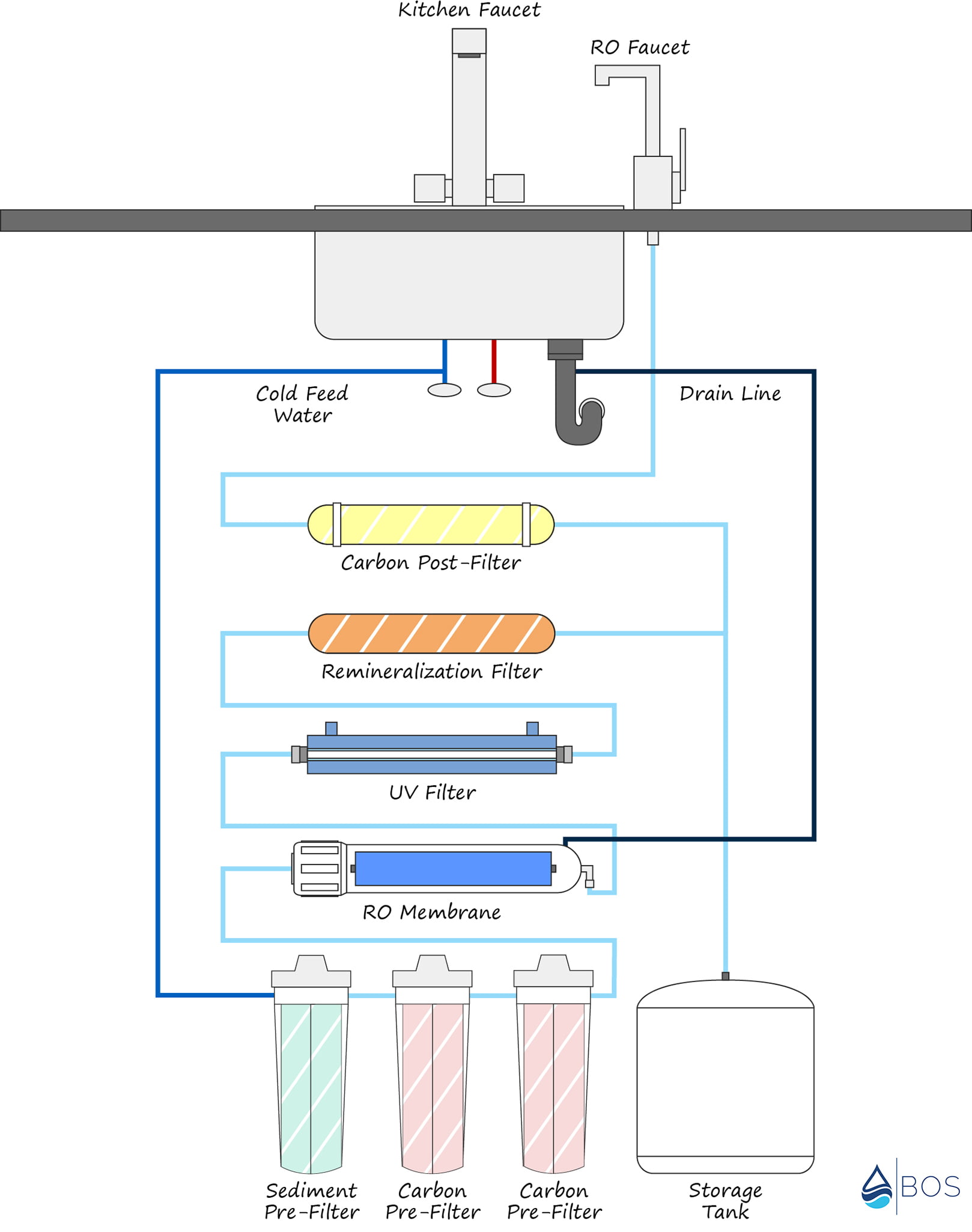7-Stage Reverse Osmosis System Diagram
Written by: Alexandra Uta // Last Updated: Aug 22, 2023
This page may contain affiliate links. If you buy a product or service through such a link we earn a commission at no extra cost to you. Learn more.
7-stage reverse osmosis is the cream of the crop for optimal water filtration.
If your water is heavily contaminated, this may be the system you want to install.
So, let’s take a look at what that might look like with this helpful diagram!
7-Stage Reverse Osmosis System Diagram
Here is our 7-stage reverse osmosis system diagram. It shows an under-sink RO water filter with one sediment pre-filter stage, two carbon pre-filters (one granular and one carbon block), the reverse osmosis membrane, a carbon post-filter, a UV purifier, a remineralization filter, a water storage tank, and the RO faucet.
How Does a 7-Stage Reverse Osmosis System Work?
The above diagram illustrates the complete process of water filtration in a 7-stage reverse osmosis system, starting from the feed water supply valve and ending with the RO faucet.
7-stage RO systems come in various configurations, typically including one sediment pre-filter, 2x carbon pre-filters, one reverse osmosis membrane, and one carbon post-filter. And then they might have UV + remineralization or any other type of “special” filter, but this is not standardized.
7-Stage Reverse Osmosis System Components
Stages of Filtration
A standard RO system comprises three foundational filter stages: Carbon pre-filtration, reverse osmosis, and post-carbon filtration. 7-stage systems often incorporate extra pre-filtration and “special” filters that can be set up in various configurations.
Sediment Pre
Dust, dirt, rust, and other particles are effectively removed through sediment filtration. Typically positioned as the initial stage, it captures larger particles. Consider it a supportive aid that guarantees optimal filtration of smaller particles and prevents potential blockages in the reverse osmosis membrane.
Carbon Pre
During this filtration stage, water passes through carbon media to eliminate undesirable flavors, odors, cloudiness, colors, and chemicals like volatile organic compounds (VOCs), chlorine, and sometimes chloramines. The primary purpose is to protect the RO membrane from potential chlorine-induced harm while improving the water’s taste.
RO Membrane
In this crucial phase, water is pushed through a semipermeable membrane featuring pores as small as 0.0001 microns. It successfully filters out 99% of impurities.
Carbon Post
After going through the process of reverse osmosis, water is stored in a tank for future use. By adding a coconut shell carbon post-filter, any lingering taste that may have transferred into the water during storage is eliminated.
Special Filters
Some special filters you may come across include:
- Remineralization filter: This adds beneficial minerals like calcium and magnesium to improve the taste of the water before it is dispensed through the RO faucet.
- UV purification filter: If your water is contaminated with bacteria, viruses, or protozoa, this filter uses UV light to disrupt their DNA, preventing replication and the spread of disease.
- Iron filters: If your water contains iron, it is recommended to treat the issue at the point of entry or consider using an iron filter stage as part of your RO system. While reverse osmosis can remove iron from drinking water, concentrations above 0.3 ppm may cause difficulties by potentially fouling sediment and carbon filters and blocking the membrane.
The Other Components
Naturally, your reverse osmosis system will include a variety of components beyond the filtration stages, specifically:
Module
A central hub that links all system components.
Water Tank
Filtered water is stored in this reservoir until required.
Water Dispenser
A water dispenser offers convenient access to filtered and purified water via a specialized faucet.
Drain Line and Saddle
This ensures the total removal of all wastewater produced by the reverse osmosis system.
Water Inlet
This is where the water supply enters the RO system.
Automatic Shut-Off Valve
The system’s operation is halted by this valve once the storage tank reaches its maximum capacity.
Check Valve
This valve serves to safeguard the RO membrane against any possible water backflow from the storage tank or drain line.
Flow Restrictor
The flow restrictor controls the water pressure, guaranteeing that the RO system maintains adequate pressure for water to pass through the membrane.
Tubing
Tubing is utilized in various sections of the system to establish connections among its components.
Fittings
These fittings guarantee secure connections and prevent any potential leaks.
How to Install a 7-Stage Reverse Osmosis Water Filter System
- Create a hole in the countertop to install the faucet.
- Below the sink, turn off the water supply and open the kitchen faucet.
- Install the feed valve and reconnect the tubing.
- Attach the drain saddle to the sink’s drain line, ensuring it is safe from the dishwasher and garbage disposal.
- Position the RO system module.
- Connect the storage tank by securely sealing the threaded port with Teflon tape and screwing on the connector.
- Establish the tubing connections.
- Install all filter cartridges and the membrane.
- Turn on the feed water valve and inspect for any leaks.
- Flush the system.
If you have any questions about our 7-stage reverse osmosis system diagram please don’t hesitate to leave a comment below!
Information provided on BOS is for educational purposes only. The products and services we review may not be right for your individual circumstances.
We adhere to strict editorial guidelines. Rest assured, the opinions expressed have not been provided, reviewed, or otherwise endorsed by our partners – they are unbiased, independent, and the author’s alone. We fact-check all content for accuracy. It is accurate as of the date posted and to the best of our knowledge.



